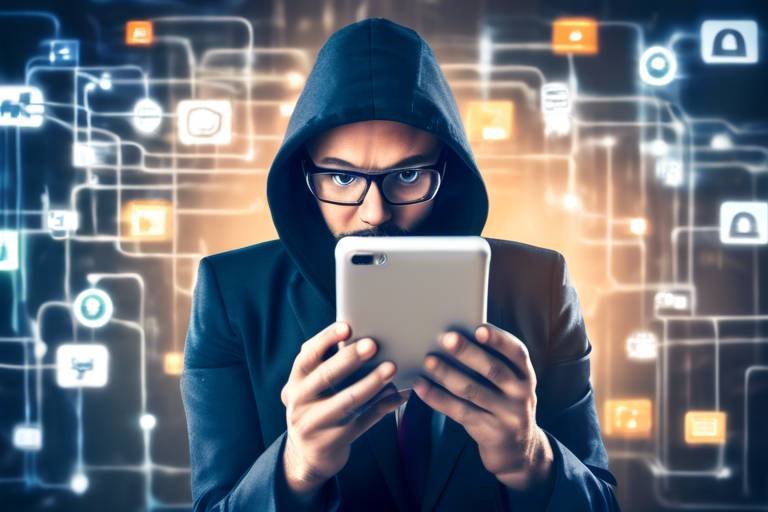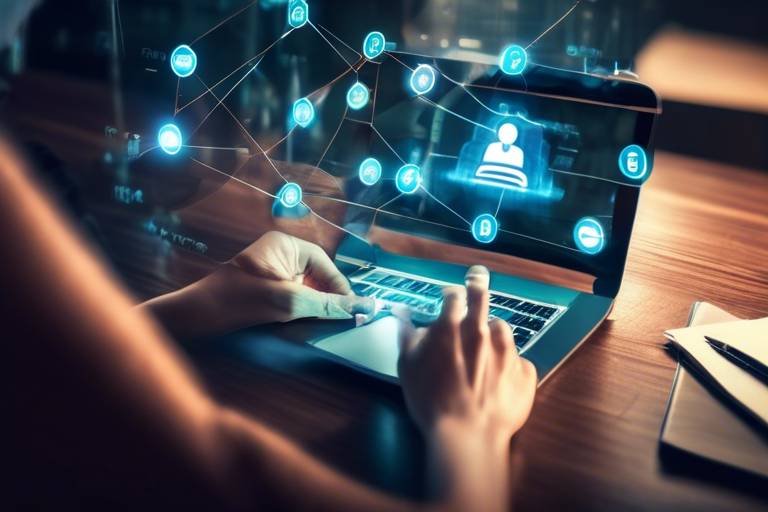Cyber Forensics - Understanding the Basics
In today's digital age, where every click can leave a trace, cyber forensics has emerged as a critical field that blends technology with investigative techniques. Imagine a detective in a crime scene, but instead of physical evidence like fingerprints or footprints, they are sifting through data, analyzing logs, and recovering deleted files. This is the essence of cyber forensics – the art and science of uncovering digital evidence to solve crimes and secure information.
As the world becomes increasingly reliant on technology, the importance of cyber forensics cannot be overstated. It serves as a vital tool for law enforcement and organizations to not only investigate cybercrimes but also to understand the underlying incidents that led to these crimes. With the rise of cyber threats, having a solid grasp of cyber forensics is like having a shield against potential attacks.
The methodologies employed in cyber forensics are diverse, ranging from data recovery techniques to network traffic analysis. Each method is designed to extract valuable insights from the digital chaos that often surrounds cyber incidents. Think of it like piecing together a jigsaw puzzle where each piece represents a fragment of information that, when assembled correctly, reveals a complete picture of what transpired.
However, the journey into cyber forensics is not without its hurdles. Rapid technological advancements often outpace forensic methodologies, creating a constant game of catch-up for professionals in the field. Moreover, the sheer volume of data generated daily can be overwhelming. Picture trying to find a needle in a haystack; that's the reality for cyber forensic experts who must sift through terabytes of data to find relevant evidence.
In this article, we will delve deeper into the importance of cyber forensics, the key principles that guide investigations, the tools used by forensic professionals, and the challenges they face. By the end, you will not only understand the basics of cyber forensics but also appreciate its significance in our digital world.
Cyber forensics plays a crucial role in investigating cybercrimes, helping organizations and law enforcement uncover evidence, understand incidents, and prevent future attacks. Its significance continues to grow in our increasingly digital world. As cyber threats evolve, so too must the strategies employed to combat them. Cyber forensics provides the framework for these strategies, enabling professionals to analyze incidents and implement measures that mitigate risks.
Understanding the foundational principles of cyber forensics is essential for effective investigations. These principles include integrity, confidentiality, and chain of custody. They guide forensic professionals in collecting and analyzing digital evidence in a manner that is both ethical and legally sound.
Maintaining the integrity of digital evidence is vital for its admissibility in court. Forensic experts use various techniques to ensure that evidence remains unaltered throughout the investigation process. This is akin to preserving a historical artifact; any alteration can lead to misinterpretation or loss of value.
Establishing a clear chain of custody is essential in cyber forensics to document who handled the evidence and how it was preserved. This process helps maintain the credibility of the findings. Think of it as a relay race; each runner (or handler) must pass the baton (evidence) without dropping it, ensuring that the race (investigation) continues smoothly and accurately.
Thorough documentation practices are crucial to record every step taken during an investigation. This ensures transparency and allows for the reproduction of the findings if needed. Imagine a recipe; if you don’t document the steps correctly, you may end up with a dish that doesn’t taste as expected. Similarly, accurate documentation in cyber forensics ensures that the investigation can be replicated and verified.
Various tools are utilized in cyber forensics to analyze data, recover deleted files, and examine network traffic. Familiarity with these tools is essential for forensic professionals to conduct thorough investigations. Some of the most commonly used tools include:
- EnCase: A powerful tool for disk imaging and data recovery.
- FTK (Forensic Toolkit): Used for data analysis and file recovery.
- Wireshark: A network protocol analyzer that helps in examining network traffic.
Cyber forensics faces numerous challenges, including rapid technological advancements, data encryption, and the sheer volume of data. Understanding these challenges is critical for developing effective forensic strategies. As technology evolves, so do the methods employed by cybercriminals, making it imperative for forensic professionals to stay ahead of the curve.
Encryption poses significant challenges for cyber forensics, as it can hinder investigators' ability to access critical information. Forensic professionals must stay updated on techniques to overcome these obstacles. Think of encryption as a locked door; while it secures information, it also requires a key to access it. Finding that key is the challenge for cyber forensic experts.
The increasing volume of digital data complicates forensic investigations. Efficient data management and analysis techniques are essential to ensure that relevant information is identified and examined promptly. Imagine trying to read a book with thousands of pages; without a systematic approach, you might miss the crucial plot twists. In cyber forensics, this means developing strategies to sift through vast amounts of information to find the critical evidence needed for a case.
What is cyber forensics?
Cyber forensics is the process of collecting, preserving, analyzing, and presenting digital evidence in a manner that is legally admissible. It is used to investigate cybercrimes and security incidents.
Why is the integrity of evidence important?
The integrity of evidence is crucial because it ensures that the evidence presented in court has not been tampered with or altered, which could compromise the investigation's findings.
What tools are commonly used in cyber forensics?
Common tools include EnCase, FTK (Forensic Toolkit), and Wireshark, which are essential for data analysis, recovery, and network traffic examination.
What are the main challenges in cyber forensics?
Key challenges include rapid technological advancements, data encryption, and the overwhelming volume of data that needs to be analyzed.

The Importance of Cyber Forensics
In today's digital landscape, the significance of cyber forensics cannot be overstated. As our lives become increasingly intertwined with technology, the potential for cybercrimes escalates. Cyber forensics serves as a beacon of hope, illuminating the dark corners of digital wrongdoing. It plays a crucial role in investigating cybercrimes, helping organizations and law enforcement uncover evidence, understand incidents, and prevent future attacks. Imagine a detective piecing together a puzzle; cyber forensics provides the tools and methodologies to solve these intricate digital mysteries.
One of the primary reasons why cyber forensics is so important is its ability to uncover hidden truths. When a cyber incident occurs, it often leaves behind a trail of digital breadcrumbs. Cyber forensic experts are trained to follow these breadcrumbs, using sophisticated tools and techniques to extract valuable information from seemingly innocuous data. This process not only helps in identifying the culprits but also assists organizations in understanding how the breach occurred, allowing them to fortify their defenses against future attacks.
Moreover, the importance of cyber forensics extends beyond mere incident response. It plays a pivotal role in legal proceedings. When digital evidence is collected and analyzed correctly, it can be presented in court to support or refute claims. Forensic experts must adhere to strict protocols to ensure the integrity of the evidence, which is paramount for its admissibility in legal contexts. Without proper cyber forensic practices, the chances of securing a conviction in cybercrime cases diminish significantly.
Another aspect worth noting is the growing demand for cyber forensic professionals. As cyber threats evolve, so does the need for skilled investigators who can keep pace with these changes. Organizations are increasingly recognizing the value of having a dedicated cyber forensics team, not just for incident response but also for proactive measures. This includes conducting regular audits, vulnerability assessments, and employee training to mitigate risks before they escalate into full-blown incidents.
To summarize, the importance of cyber forensics can be encapsulated in the following key points:
- Incident Investigation: It helps uncover the facts behind cyber incidents.
- Legal Support: Provides crucial evidence for legal proceedings.
- Preventive Measures: Aids organizations in fortifying their defenses.
- Skill Demand: Creates job opportunities for forensic professionals.
In an era where data breaches and cyber threats are rampant, understanding the importance of cyber forensics is essential. It acts as a safeguard, ensuring that justice is served and that organizations can learn from their mistakes. As we continue to navigate this digital age, the role of cyber forensics will only become more critical, highlighting the need for ongoing education and adaptation in this dynamic field.

Key Principles of Cyber Forensics
When diving into the realm of cyber forensics, it's essential to understand the foundational principles that guide every investigation. These principles aren't just technical jargon; they form the backbone of how forensic professionals operate, ensuring that every piece of evidence is handled with the utmost care and precision. Let's break down these key principles, which include integrity, confidentiality, and the chain of custody.
First and foremost, maintaining the integrity of digital evidence is vital for its admissibility in court. Imagine you're a detective trying to solve a mystery; if the clues you gather are tampered with, your entire case can fall apart. Forensic experts employ various techniques to ensure that evidence remains untouched throughout the investigation process. They utilize methods like hashing, which creates a unique digital fingerprint of the data, ensuring that any alteration can be detected. This means that if a file is changed even slightly, the hash will no longer match, alerting investigators to potential issues.
Establishing a clear chain of custody is another cornerstone of cyber forensics. This process documents who handled the evidence, when it was accessed, and how it was preserved. Think of it as a relay race—each runner (or handler) must pass the baton (the evidence) without dropping it. If there’s a gap in the chain, the credibility of the findings can be questioned. A well-maintained chain of custody not only protects the evidence but also strengthens the case in legal proceedings.
Thorough documentation practices are crucial during an investigation. Every step taken must be recorded meticulously, from the moment evidence is collected to the final analysis. This ensures transparency and allows for the reproduction of findings if needed. For instance, if a forensic analyst discovers a critical piece of evidence, they must document how it was found, the tools used, and the methods applied. This level of detail not only supports the findings but also builds trust in the entire investigative process.
In conclusion, understanding these key principles of cyber forensics is essential for anyone interested in the field. They guide professionals in collecting and analyzing digital evidence responsibly and effectively. By adhering to these principles, forensic experts can ensure that their findings are reliable, credible, and most importantly, usable in a court of law.
- What is cyber forensics? Cyber forensics is the practice of collecting, analyzing, and preserving digital evidence from computers and networks to investigate cybercrimes.
- Why is the integrity of evidence important? The integrity of evidence is crucial because it ensures that the evidence presented in court has not been altered, which is vital for a fair legal process.
- What does chain of custody mean? The chain of custody refers to the process of maintaining and documenting the handling of evidence, ensuring its integrity and credibility throughout the investigation.
- What tools are commonly used in cyber forensics? Tools like EnCase, FTK, and Wireshark are commonly used for data recovery, analysis, and network traffic examination in cyber forensics.

Integrity of Evidence
The is a cornerstone of cyber forensics, ensuring that the digital footprints left behind during cyber incidents remain intact and untainted. Imagine a detective piecing together a puzzle—the integrity of each piece is crucial for revealing the full picture. If even one piece is altered or compromised, the entire investigation could lead to incorrect conclusions. In the realm of cyber forensics, this integrity is maintained through a series of meticulous practices and technologies designed to protect digital evidence from tampering.
One of the primary methods used to ensure integrity is the application of hashing algorithms. These algorithms generate a unique digital fingerprint for a file or data set, allowing forensic experts to verify that the evidence has not been altered. For instance, if a forensic investigator hashes a file before and after examination, any discrepancy in the hash values indicates that the file has been modified. This practice is akin to sealing a letter in an envelope; if the seal is broken, you know someone has tampered with its contents.
Moreover, maintaining a proper chain of custody is essential in preserving evidence integrity. This process involves documenting every individual who handles the evidence, the time and date of each transfer, and the conditions under which the evidence was stored. A well-maintained chain of custody acts like a secure vault, providing a clear history that reinforces the credibility and reliability of the evidence presented in court. Without this documentation, the evidence might be dismissed as unreliable, undermining the entire investigation.
Forensic investigators also employ various tools and software designed to create forensic images of devices. A forensic image is a bit-by-bit copy of a storage device, capturing all data, including deleted files, without altering the original evidence. This technique allows investigators to work on a copy while preserving the original, much like an artist creating a replica of a priceless painting without touching the original canvas.
In conclusion, the integrity of evidence in cyber forensics is not just a procedural formality; it is a vital aspect that upholds the very foundation of digital investigations. By utilizing hashing, maintaining a rigorous chain of custody, and employing forensic imaging techniques, professionals in this field can ensure that the evidence they collect is both reliable and admissible in legal proceedings.
- What is the role of hashing in cyber forensics? Hashing is used to create a unique digital fingerprint for files, ensuring that any alterations can be detected.
- Why is the chain of custody important? It documents the handling of evidence, maintaining its credibility and reliability in court.
- What is a forensic image? A forensic image is a complete, bit-by-bit copy of a storage device that allows investigators to analyze data without altering the original evidence.

Chain of Custody
The is a fundamental concept in cyber forensics, acting as the backbone of any investigation involving digital evidence. It refers to the process of maintaining and documenting the handling of evidence from the moment it is collected until it is presented in court. Think of it like a relay race; each participant must pass the baton (the evidence) without dropping it, ensuring that it remains intact and unaltered. This meticulous documentation is not just a bureaucratic formality; it is essential for establishing the credibility of the evidence.
To ensure a strong chain of custody, forensic experts follow a series of steps that include:
- Identification: Clearly identifying the evidence and its source.
- Collection: Collecting the evidence using methods that prevent alteration.
- Documentation: Recording every detail about the evidence, including time, date, and the identity of the person who collected it.
- Storage: Storing the evidence in a secure environment to prevent tampering.
- Transfer: Documenting any transfer of the evidence between parties.
Each of these steps is crucial in preserving the integrity of the evidence. If even one link in the chain is broken, it can lead to questions about the evidence's validity, potentially jeopardizing the entire case. For instance, if evidence is mishandled or poorly documented, a defense attorney might argue that it was tampered with, leading to the evidence being deemed inadmissible in court.
Furthermore, the documentation process must be meticulous. Forensic professionals often use a standardized form to record information about the evidence, which includes:
| Field | Description |
|---|---|
| Date and Time | The exact date and time the evidence was collected. |
| Location | The specific location where the evidence was found. |
| Collector's Name | The name of the individual who collected the evidence. |
| Condition | A description of the evidence's condition at the time of collection. |
| Storage Location | The location where the evidence will be securely stored. |
In conclusion, the chain of custody is not merely a procedural requirement; it is a vital component of any cyber forensic investigation. By ensuring that each piece of evidence is handled with care and documented thoroughly, forensic professionals can maintain its integrity and reliability, ultimately supporting the pursuit of justice in the digital age.
What is the purpose of the chain of custody in cyber forensics?
The chain of custody ensures that digital evidence is collected, preserved, and handled properly, maintaining its integrity and admissibility in court.
What can happen if the chain of custody is broken?
If the chain of custody is broken, the evidence may be deemed inadmissible in court, potentially jeopardizing the entire case.
How is evidence documented in the chain of custody?
Evidence is documented through detailed records that include information such as the date and time of collection, the location, the collector's name, and the condition of the evidence.
Why is secure storage important for evidence?
Secure storage is crucial to prevent tampering or alteration of the evidence, which could compromise its integrity.

Documentation Practices
When it comes to cyber forensics, are not just a formality; they are the backbone of any investigation. Imagine trying to solve a complex puzzle without keeping track of where each piece came from. That’s what it’s like to conduct a forensic investigation without proper documentation. Every action taken, every piece of evidence collected, and every analysis performed must be meticulously recorded. This ensures that the investigation can be replicated and verified by others, which is crucial in legal contexts.
Effective documentation involves several key components:
- Detailed Logs: Forensic experts should maintain detailed logs of their activities. This includes timestamps, descriptions of actions taken, and the personnel involved. Think of it as a diary for the investigation, capturing every significant moment.
- Chain of Custody Forms: These forms are essential for maintaining the integrity of the evidence. They document who collected the evidence, how it was stored, and who accessed it at any given time. This transparency is vital for establishing trust in the findings.
- Analysis Reports: After analyzing the data, forensic professionals must compile comprehensive reports that summarize their findings. These reports should be clear and concise, making it easier for stakeholders, including law enforcement and legal teams, to understand the implications of the evidence.
Moreover, documentation practices should not be an afterthought. They should be integrated into every stage of the investigation process. From the moment evidence is collected to the final report, each step should be carefully documented. This not only helps in maintaining the integrity of the investigation but also aids in future training and knowledge sharing among forensic professionals.
In addition to these practices, utilizing digital tools for documentation can enhance efficiency. For example, forensic software often comes equipped with built-in documentation features that automatically log actions taken during an investigation. This reduces the chances of human error and ensures that all necessary information is captured accurately.
In conclusion, robust documentation practices in cyber forensics are essential for ensuring the credibility and reliability of investigations. They serve as a safeguard against potential challenges in legal settings and help maintain the integrity of the evidence. By treating documentation as a critical component of the forensic process, professionals can enhance the effectiveness of their investigations and contribute to a more secure digital landscape.
- What is the purpose of documentation in cyber forensics? Documentation serves to record every step of the investigation, ensuring transparency and the ability to reproduce findings in legal contexts.
- How can digital tools aid in documentation? Digital tools can automate the documentation process, reducing human error and ensuring all necessary information is captured accurately.
- What happens if documentation is inadequate? Inadequate documentation can lead to challenges in court, as it may compromise the integrity of the evidence and the findings of the investigation.

Common Tools Used in Cyber Forensics
In the realm of cyber forensics, having the right tools at your disposal is akin to a chef having the best knives in the kitchen. These tools are essential for forensic professionals to analyze data, recover deleted files, and scrutinize network traffic. With the increasing sophistication of cybercrimes, the demand for effective forensic tools has never been higher. Let's dive into some of the most widely used tools in the field and understand their significance.
One of the fundamental tools in cyber forensics is EnCase. This software is renowned for its ability to create forensic images of hard drives, ensuring that the original data remains untouched. EnCase also allows investigators to perform in-depth analysis on the captured data, making it invaluable for both law enforcement and corporate investigations. Similarly, FTK (Forensic Toolkit) is another powerful tool that aids in data analysis and recovery. It provides features like file carving, which can recover deleted files, and a comprehensive database for managing evidence.
Another notable mention is Wireshark, a network protocol analyzer that enables forensic experts to capture and inspect data packets traveling through a network. This tool is crucial when investigating network breaches or unauthorized access, as it provides insights into the traffic patterns and potential vulnerabilities. Additionally, Autopsy is an open-source digital forensics platform that simplifies the process of analyzing hard drives and smartphones. It offers a user-friendly interface, making it accessible for those new to digital forensics.
When it comes to mobile forensics, tools like Cellebrite and Oxygen Forensics stand out. These tools specialize in extracting data from mobile devices, including text messages, call logs, and application data. As mobile devices become integral to our lives, the importance of these tools in cyber investigations cannot be overstated.
In addition to these specific tools, forensic professionals often rely on a combination of software and hardware solutions. For example, utilizing write blockers ensures that the original data is not altered during the imaging process. This is crucial for maintaining the integrity of evidence. Furthermore, data recovery tools such as Recuva and R-Studio are employed to retrieve lost or deleted files, offering a second chance at recovering critical information.
In summary, the landscape of cyber forensics is equipped with a diverse array of tools, each serving a unique purpose. From data recovery to network analysis, these tools empower forensic experts to uncover the truth behind cyber incidents. As technology continues to evolve, staying updated with the latest tools and techniques is essential for anyone involved in this dynamic field.
- What is the primary purpose of cyber forensics?
Cyber forensics aims to investigate cybercrimes by collecting, analyzing, and preserving digital evidence to support legal proceedings. - How important is maintaining the integrity of evidence?
Maintaining evidence integrity is crucial for its admissibility in court, as any alteration can compromise the investigation's credibility. - What types of data can be recovered using cyber forensics tools?
Forensic tools can recover a variety of data including deleted files, emails, text messages, and even data from mobile devices. - Are there any challenges faced in cyber forensics?
Yes, challenges include data encryption, the vast volume of data, and rapidly changing technology, which can complicate investigations.

Challenges in Cyber Forensics
In the thrilling yet complex world of cyber forensics, professionals face a myriad of challenges that can make investigations feel like navigating a labyrinth. As technology evolves at lightning speed, the tools and methodologies used in cyber forensics must also adapt. One of the most significant hurdles is the rapid advancement of technology itself. Imagine trying to catch a train that’s constantly moving faster; that’s what forensic experts encounter with new software and hardware emerging almost daily. This relentless pace can leave investigators struggling to keep up, often requiring continuous education and adaptation.
Another formidable challenge is data encryption. As individuals and organizations increasingly prioritize privacy, they often employ robust encryption methods to protect their sensitive information. While this is a positive step for data security, it creates a double-edged sword for cyber forensics. Investigators may find themselves locked out of critical evidence, much like trying to unlock a treasure chest without the key. Forensic professionals must stay abreast of the latest decryption techniques and tools to effectively navigate these barriers.
The sheer volume of data generated daily is yet another obstacle. With billions of emails, social media posts, and transactions occurring every minute, the amount of information that needs to be sifted through can be overwhelming. Just picture trying to find a needle in a haystack, but the haystack is growing larger by the second! To combat this, forensic experts are increasingly utilizing advanced data management and analysis techniques. These tools help them filter out the noise and focus on the relevant data that could lead to crucial findings.
Moreover, the diversity of devices and platforms also complicates investigations. From smartphones to cloud storage, each device may store data in different formats and locations. This variability requires forensic professionals to be well-versed in multiple systems and technologies, adding another layer of complexity to their work. It’s akin to being a multilingual traveler in a foreign country, where understanding the nuances of each language is essential for effective communication.
Finally, the legal landscape surrounding cyber forensics is continually shifting. Laws regarding digital evidence and privacy can vary significantly from one jurisdiction to another, creating a patchwork of regulations that forensic experts must navigate. This can lead to further complications in the investigation process, as what is permissible in one area may not be in another. As a result, staying informed about these legal changes is crucial for professionals in the field.
In summary, while the challenges in cyber forensics are numerous and complex, they are not insurmountable. By embracing continuous learning, leveraging advanced tools, and maintaining a keen awareness of legal standards, forensic experts can effectively tackle these obstacles and continue to play a vital role in the fight against cybercrime.
- What is cyber forensics? Cyber forensics is the process of collecting, analyzing, and preserving digital evidence to investigate cybercrimes and incidents.
- Why is data encryption a challenge in cyber forensics? Data encryption protects sensitive information, making it difficult for forensic experts to access critical evidence needed for investigations.
- How do forensic professionals manage the volume of data? They utilize advanced data management and analysis tools to filter out irrelevant information and focus on pertinent data.
- What legal considerations do cyber forensics experts need to keep in mind? They must stay informed about varying laws and regulations regarding digital evidence and privacy, as these can differ by jurisdiction.

Data Encryption Issues
Data encryption is a double-edged sword in the realm of cyber forensics. On one hand, it serves as a vital security measure, protecting sensitive information from unauthorized access. On the other hand, it presents significant challenges for forensic investigators who need to access encrypted data to uncover evidence related to cybercrimes. Imagine trying to solve a puzzle with missing pieces; that's what forensic experts face when they encounter encrypted data.
Encryption technologies have become increasingly sophisticated, making it difficult for investigators to decrypt information without the proper keys. This situation can lead to a frustrating scenario where crucial evidence remains locked away, potentially hindering investigations and delaying justice. Forensic professionals must constantly adapt to these evolving encryption methods, employing a variety of strategies to navigate these complex barriers.
Some of the common encryption techniques that can complicate cyber forensic investigations include:
- Symmetric Encryption: This method uses a single key for both encryption and decryption. If the key is lost or not available, accessing the data becomes nearly impossible.
- Asymmetric Encryption: Utilizing a pair of keys (public and private), this method adds another layer of complexity. Without the private key, decrypting the data is a formidable challenge.
- Full Disk Encryption: This technique encrypts the entire hard drive, making it difficult to retrieve any data without the proper credentials.
In addition to the technical challenges, there are also legal and ethical considerations surrounding data encryption. For instance, the balance between privacy rights and the need for law enforcement to access information can lead to heated debates. Forensic experts must navigate these waters carefully, ensuring they adhere to legal standards while seeking the truth.
To tackle these encryption issues effectively, forensic professionals often rely on specialized tools and techniques. Some of these include:
| Tool/Technique | Description |
|---|---|
| Forensic Decryption Software | Tools designed to decrypt data by exploiting weaknesses in encryption algorithms. |
| Brute Force Attacks | A method that attempts every possible combination of keys until the correct one is found. |
| Keyloggers | Malware that records keystrokes, potentially capturing encryption keys as they are entered. |
In conclusion, while encryption is essential for securing data, it poses substantial challenges for cyber forensics. As technology continues to advance, forensic professionals must stay ahead of the curve, continuously learning and adapting their strategies to effectively tackle encrypted evidence. The fight against cybercrime is a constant battle, and understanding encryption issues is a critical piece of the puzzle.
- What is data encryption? Data encryption is the process of converting information into a code to prevent unauthorized access.
- Why is data encryption a challenge for cyber forensics? Because it can prevent forensic investigators from accessing critical evidence needed to solve cybercrimes.
- What tools do forensic professionals use to deal with encryption? They utilize forensic decryption software, brute force attacks, and keyloggers, among other techniques.

Volume of Data
The sheer volume of digital data generated today is staggering. Every minute, countless transactions, communications, and interactions occur online, creating an avalanche of information that can be both a treasure trove and a challenge for cyber forensics professionals. Imagine trying to find a needle in a haystack, but the haystack is constantly growing! This is the reality faced by forensic investigators as they sift through terabytes of data to find relevant evidence.
As organizations expand their digital footprints, the amount of data they generate multiplies exponentially. This growth is fueled by various factors, including the rise of social media, the Internet of Things (IoT), and big data technologies. For instance, consider the following statistics:
| Data Generation Source | Estimated Data Generated per Minute |
|---|---|
| Over 4 million posts | |
| Over 500,000 tweets | |
| Over 95 million photos | |
| Emails | Over 197.6 million emails |
With such an overwhelming amount of data being produced, forensic investigators must employ efficient data management and analysis techniques. This includes leveraging advanced software tools and algorithms that can help filter out noise and highlight relevant information. For instance, machine learning and artificial intelligence are increasingly being integrated into forensic processes to automate data sorting and enhance the speed of investigations.
Moreover, the challenge of data volume is compounded by the need for precision and accuracy. Investigators must ensure that they do not overlook critical evidence while navigating through the vast sea of information. This is where robust data analytics come into play, allowing forensic experts to visualize data patterns and identify anomalies that may indicate suspicious activities.
In summary, the presents both challenges and opportunities in the field of cyber forensics. As technology continues to evolve, so too must the strategies used to manage and analyze this data. The ability to adapt and innovate will be crucial for forensic professionals aiming to stay ahead in this fast-paced digital landscape.
- What is cyber forensics? Cyber forensics is the practice of collecting, analyzing, and preserving digital evidence to investigate cybercrimes.
- Why is the volume of data a challenge in cyber forensics? The increasing volume of data complicates investigations, making it difficult to identify relevant information quickly.
- How do forensic professionals manage large amounts of data? They use advanced tools and techniques, including machine learning and data analytics, to streamline the process.
- What role does data encryption play in cyber forensics? Encryption can hinder access to critical information, posing challenges for investigators trying to retrieve evidence.
Frequently Asked Questions
- What is cyber forensics?
Cyber forensics is the field dedicated to investigating and analyzing digital evidence from computers, networks, and other electronic devices. It aims to uncover information related to cybercrimes, ensuring that evidence is collected and preserved in a manner that is admissible in court.
- Why is cyber forensics important?
Cyber forensics is crucial because it helps organizations and law enforcement agencies understand the nature of cyber incidents, recover lost data, and prevent future attacks. In our digital age, the ability to investigate and resolve cybercrimes is increasingly vital for maintaining security and trust.
- What are the key principles of cyber forensics?
The key principles include integrity, confidentiality, and chain of custody. These principles guide forensic professionals in ensuring that digital evidence is collected and analyzed properly, maintaining its credibility throughout the investigation process.
- How is the integrity of evidence maintained?
To maintain the integrity of evidence, forensic experts use various techniques such as hashing, which creates a unique digital fingerprint of the data. This ensures that any changes to the evidence can be detected, preserving its authenticity for legal proceedings.
- What is the chain of custody?
The chain of custody refers to the process of documenting who handled the evidence and how it was preserved throughout the investigation. This is essential for establishing the credibility of the findings and ensuring that the evidence can be trusted in a courtroom setting.
- What tools are commonly used in cyber forensics?
Common tools include data recovery software, network analysis tools, and forensic imaging software. These tools help forensic professionals analyze data, recover deleted files, and examine network traffic to gather valuable evidence.
- What challenges do cyber forensics professionals face?
Professionals face several challenges, including rapid technological advancements, data encryption, and the sheer volume of digital data. These factors can complicate investigations and require forensic experts to stay updated on the latest techniques and tools.
- How does data encryption affect cyber forensics?
Data encryption can pose significant challenges as it may prevent investigators from accessing critical information. Forensic professionals need to employ advanced techniques to bypass encryption and retrieve necessary data while adhering to legal guidelines.
- Why is managing the volume of data important in cyber forensics?
The increasing volume of digital data complicates investigations, making it essential to have efficient data management and analysis techniques. This ensures that relevant information is identified and examined promptly, aiding in a successful investigation.



















